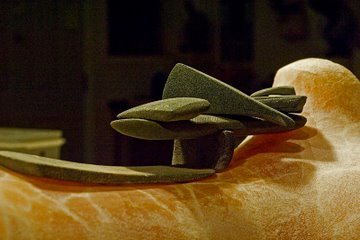
Home » Carve » Experience » Getting Started » Another use of Grinding Wheels – Hand Shaping

This morning I followed up to what I saw Lee Gass doing. He was “sanding” with a piece of a bench grinder wheel. I have a few spares so I smashed one with a sledge hammer and ended up with a whole bunch of useful hand-sanders. Curves, angles. Plus I shaped them further on my angle grinder clamped to my table. They worked better with water…. HAPPY NEW YEAR. — Dirk
On 19-Dec-09, at 2:29 PM, verena schwippert wrote:
..yes Dirk, but only under the sanding of particular type of stone you are working on. What is it ? Its different for every kind of stone.
…yup it is. — V
Silicon Carbide Shapers – Right on, V! Actually, those small pieces of silicon carbide work well for hardnesses from soft marble to hard granite. With each of those materials, hard rubbing with a piece conforming well to the surface produces
a steady outwash of milky mud that make take as much as 2 or 3 drips per second of water to carry it away and prevent the slurry from interfering with the cutting.
Because I use each shape of silicon carbide for a small range of curvatures, they wear uniformly, retaining their form and remaining useful as a specialized tool. I have two freezer containers full of pieces like this, some of them 20 years old.
Dirk mentioned grinding wheels (120 or 220 grit GC grade). Sometimes, if they are cracked and the distributor can’t sell them otherwise, it may be possible to buy big wheels cheap. I have also bought flat sheets of abrasive for cutting up.
Question: Back in the olden days, until some time in the late 1980s if I’m remembering right, I used to be able to buy something called “scythe sticks“. They were about a foot long, barrel-shaped in cross section, about 2″ wide, about 1/4″ thick at both edges and 3/4” thick in the belly. Both curved surfaces, each approximating a section of a large-diameter cylinder, were scored with diagonal grooves, shallow like those on a file.
Scythe sticks could cut! Marble. Granite. Travertine. Onyx. Basalt. They could cut them all, and I loved them. If I’d had sense to buy a gross of them before they disappeared I’d be a much happier man today. But I didn’t, and I’m one miserable S.O.B. I haven’t seen a scythe stick for 15 or 20 years, and my hoarding is getting ridiculous.
They were great for three kinds of uses. First, used as files, they were wonderful for developing saddle shapes, like passes in mountain ranges. Second, for all kinds of curvatures both concave and convex, I used whole scythe sticks like push-scrapers, allowing just the end to wear to a particular shape. I usually allowed just one side of one end to wear to a convex curvature for scraping concavities, and the other to a concave curvature for scraping convexities. Because scythe sticks were long and had an easy-to-grasp cross-section, they were two-handed tools and I could really bear down on them on both kinds of surfaces. In that case, a few drops of water couldn’t even touch the mud and I practically had to use a fire hose to keep the contact zone visible, clean, and biting hard. Third, I cut scythe sticks into shorter lengths and allowed one side to wear convex and the other concave. Because the matrix of the abrasive was very strong, pieces shaped like that could wear to considerably less than 1/4″ thick before breaking.
I loved scythe sticks. I think anyone not addicted to power shaping would love them. I’m not talking about sanding here; sanding comes later. I’m talking about shaping, while I’m still moving stone and tuning form. Small pieces of silicon carbide are useful for shaping but ANTI-useful for finishing. Because the material is absolutely inflexible, it is only in rare cases a perfect fit with the surface it abrades. Necessarily, it contacts different parts of curved surfaces with different pressure, so it can and will produce deep scratches in even hard material. — Lee Gass
P.S. Help! If anyone can find me some scythe sticks to buy, I’ll be ecstatic. I’ll bet there’s a case of them somewhere (maybe where people still use scythes).
In response On 25-Jan-10 Gus Schairer provided a reason for Lee to be ecstatic: Amazon.com has them from Bic Supply: “ALI INDUSTRIES #6055 Scythe Sharpening Stone” for $3.06 plus $7.16 shipping(Sounds like a real item for bulk/group purchase – maybe someone should bring a case to Camp B)
Furthermore he adds: I used the scythe stone on some large crystal marble and it worked great, better than my rasps for achieving the form I wanted and didn’t leave the deep scratches that need sanding out. It doesn’t work as well on really soft stone as it gets filled too quickly. It’s oval shape is good for inside curves, too. As Lee says, it is helpful for rough shaping, being more course that 50 grit stones and smoothes well after filing with course rasps and carborundum files. It’s a good “tweener” shaper, ‘tween course and fine.

We need some kind of descriptive text here.